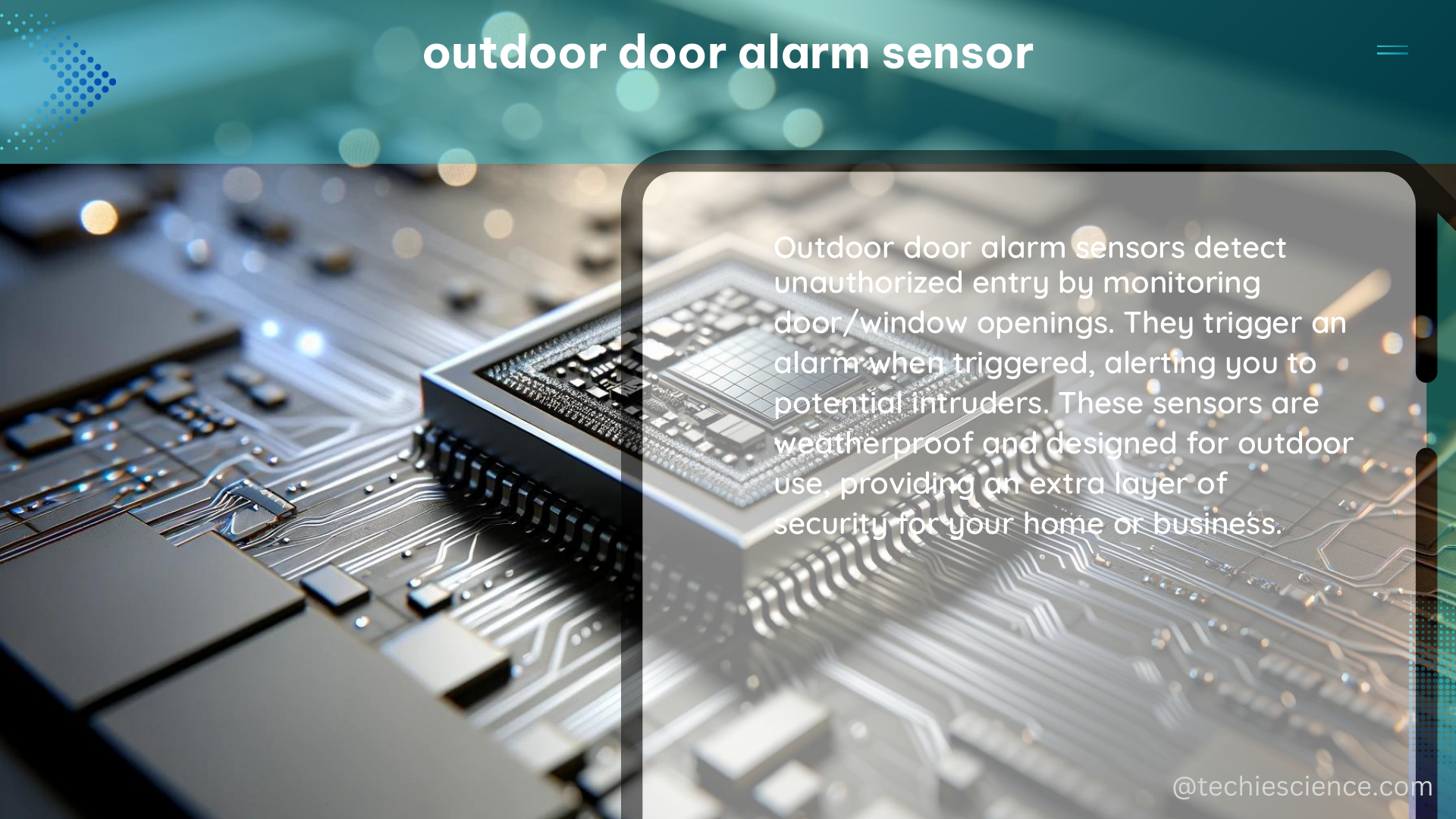Outdoor door alarm sensors are a crucial component of a robust home security system, designed to detect and promptly alert homeowners of any unauthorized entry. These sensors employ advanced technologies, such as magnetic and infrared detection, to provide comprehensive protection for your property. In this comprehensive guide, we will delve into the intricate details of outdoor door alarm sensors, exploring their sensor types, range, battery life, environmental ratings, and installation considerations to help you make an informed decision for your home security needs.
Sensor Types: Magnetic vs. Infrared
The two primary sensor types for outdoor door alarm sensors are magnetic and infrared. Magnetic Sensors: These sensors consist of two parts: a magnet and a sensor. When the door or window is closed, the magnet is in close proximity to the sensor, completing a circuit. When the door or window is opened, the magnet moves away from the sensor, breaking the circuit and triggering the alarm. The Aeotec Recessed Door Sensor, for example, utilizes a magnetic sensor with a detection range of up to 1.5 inches (3.8 cm).
Infrared Sensors: These sensors employ passive infrared (PIR) technology to detect motion within a specific range and angle. The Amcrest SmartHome WiFi Door Alarm System, for instance, features a PIR motion sensor with a detection distance of 26 feet (7.9 m) and a detection angle of 110°. The Honeywell 5800MINI Wireless Door/Window Sensor, on the other hand, has a detection range of up to 40 feet (12.2 m).
Sensor Range: Maximizing Coverage

The range of an outdoor door alarm sensor is a crucial factor to consider, as it determines the maximum distance between the sensor and the alarm system or hub. This parameter is particularly important for larger properties or installations with multiple entry points.
| Sensor Model | Range in Open Field |
|---|---|
| Amcrest SmartHome WiFi Door Alarm System | 328 feet (100 m) |
| Aeotec Recessed Door Sensor | 100 feet (30.5 m) |
| Honeywell 5800MINI Wireless Door/Window Sensor | 200 feet (61 m) |
It’s important to note that the actual range may be affected by environmental factors, such as walls, furniture, and other obstructions, which can reduce the effective range of the sensor.
Battery Life: Ensuring Uninterrupted Protection
Battery life is a critical consideration for outdoor door alarm sensors, as they are often installed in locations without easy access to power outlets. The battery life of these sensors can vary significantly, depending on the sensor model and the usage patterns.
| Sensor Model | Battery Type | Estimated Battery Life |
|---|---|---|
| Aqara Contact Sensor | CR123A | Up to 5 years |
| Honeywell 5800MINI Wireless Door/Window Sensor | CR2032 | Up to 5-7 years |
| Amcrest SmartHome WiFi Door Alarm System | 4 x AA batteries | Up to 1 year |
It’s essential to regularly monitor the battery levels of your outdoor door alarm sensors and replace them as needed to ensure uninterrupted protection for your home.
Environmental Ratings: Weatherproofing for Outdoor Use
Outdoor door alarm sensors must be able to withstand various environmental conditions, such as rain, snow, and extreme temperatures, to maintain their reliability and functionality.
| Sensor Model | Operating Temperature Range |
|---|---|
| Amcrest SmartHome WiFi Door Alarm System | 14°F to 131°F (-10°C to +55°C) |
| Aeotec Recessed Door Sensor | -4°F to 140°F (-20°C to +60°C) |
| Honeywell 5800MINI Wireless Door/Window Sensor | -4°F to 140°F (-20°C to +60°C) |
For outdoor installations, it is essential to ensure that the sensor is adequately protected from the elements, either through a waterproof enclosure or by selecting a sensor specifically designed for outdoor use, such as the Aeotec Recessed Door Sensor, which has an IP67 rating for water and dust resistance.
DIY Installation: Effortless Setup
Many outdoor door alarm sensors are designed for DIY installation, requiring no tools and causing minimal damage to the installation surface. This feature makes them an attractive option for homeowners who want to enhance their home security without the need for professional installation.
The Amcrest SmartHome WiFi Door Alarm System, for example, can be easily set up in minutes without tools, with the alarm station connecting via a USB cable to the AC adapter. The Aeotec Recessed Door Sensor, on the other hand, can be installed by drilling a small hole in the door frame and inserting the sensor.
Conclusion
Outdoor door alarm sensors are a crucial component of a comprehensive home security system, providing reliable detection and prompt notification of unauthorized entry. By understanding the intricacies of sensor types, range, battery life, environmental ratings, and installation considerations, homeowners can make an informed decision and select the outdoor door alarm sensor that best suits their security needs and environmental conditions.
Remember, the key to effective home security lies in a well-designed and properly installed system. By carefully evaluating the features and specifications of outdoor door alarm sensors, you can ensure that your property is protected from potential threats, giving you peace of mind and the confidence to enjoy your home to the fullest.
References:
- Recommendation for Outdoor Door Sensor
- Waterproof Outdoor Contact Sensor Recommendations
- Amcrest SmartHome Wireless Door Alarm System
- Aeotec Recessed Door Sensor
- Honeywell 5800MINI Wireless Door/Window Sensor

The lambdageeks.com Core SME Team is a group of experienced subject matter experts from diverse scientific and technical fields including Physics, Chemistry, Technology,Electronics & Electrical Engineering, Automotive, Mechanical Engineering. Our team collaborates to create high-quality, well-researched articles on a wide range of science and technology topics for the lambdageeks.com website.
All Our Senior SME are having more than 7 Years of experience in the respective fields . They are either Working Industry Professionals or assocaited With different Universities. Refer Our Authors Page to get to know About our Core SMEs.